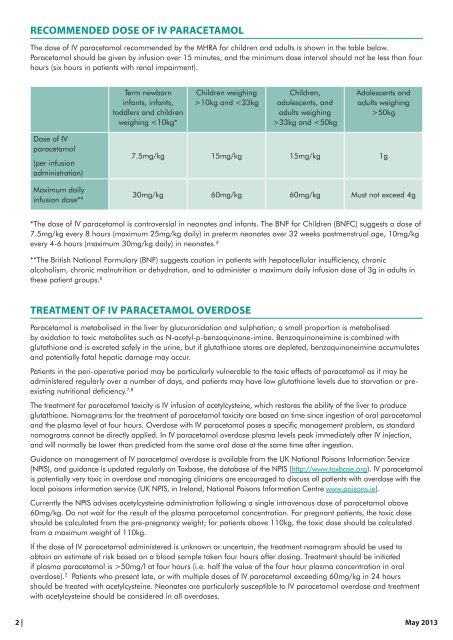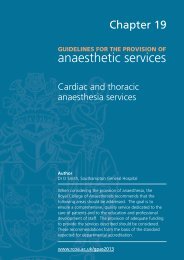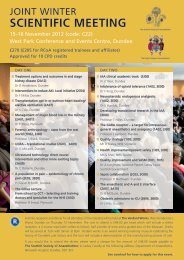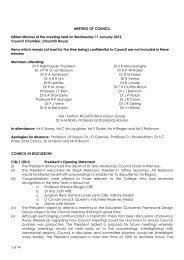INTRAVENOUS PARACETAMOL
INTRAVENOUS PARACETAMOL
INTRAVENOUS PARACETAMOL
You also want an ePaper? Increase the reach of your titles
YUMPU automatically turns print PDFs into web optimized ePapers that Google loves.
Recommended dose of IV paracetamol<br />
The dose of IV paracetamol recommended by the MHRA for children and adults is shown in the table below.<br />
Paracetamol should be given by infusion over 15 minutes, and the minimum dose interval should not be less than four<br />
hours (six hours in patients with renal impairment).<br />
Term newborn<br />
infants, infants,<br />
toddlers and children<br />
weighing 10kg and 33kg and 50kg<br />
Dose of IV<br />
paracetamol<br />
(per infusion<br />
administration)<br />
Maximum daily<br />
infusion dose**<br />
7.5mg/kg 15mg/kg 15mg/kg 1g<br />
30mg/kg 60mg/kg 60mg/kg Must not exceed 4g<br />
*The dose of IV paracetamol is controversial in neonates and infants. The BNF for Children (BNFC) suggests a dose of<br />
7.5mg/kg every 8 hours (maximum 25mg/kg daily) in preterm neonates over 32 weeks postmenstrual age, 10mg/kg<br />
every 4-6 hours (maximum 30mg/kg daily) in neonates. 6<br />
**The British National Formulary (BNF) suggests caution in patients with hepatocellular insufficiency, chronic<br />
alcoholism, chronic malnutrition or dehydration, and to administer a maximum daily infusion dose of 3g in adults in<br />
these patient groups. 6<br />
Treatment of IV paracetamol overdose<br />
Paracetamol is metabolised in the liver by glucuronidation and sulphation; a small proportion is metabolised<br />
by oxidation to toxic metabolites such as N-acetyl-p-benzoquinone-imine. Benzoquinoneimine is combined with<br />
glutathione and is excreted safely in the urine, but if glutathione stores are depleted, benzoquinoneimine accumulates<br />
and potentially fatal hepatic damage may occur.<br />
Patients in the peri-operative period may be particularly vulnerable to the toxic effects of paracetamol as it may be<br />
administered regularly over a number of days, and patients may have low glutathione levels due to starvation or preexisting<br />
nutritional deficiency. 7,8<br />
The treatment for paracetamol toxicity is IV infusion of acetylcysteine, which restores the ability of the liver to produce<br />
glutathione. Nomograms for the treatment of paracetamol toxicity are based on time since ingestion of oral paracetamol<br />
and the plasma level at four hours. Overdose with IV paracetamol poses a specific management problem, as standard<br />
nomograms cannot be directly applied. In IV paracetamol overdose plasma levels peak immediately after IV injection,<br />
and will normally be lower than predicted from the same oral dose at the same time after ingestion.<br />
Guidance on management of IV paracetamol overdose is available from the UK National Poisons Information Service<br />
(NPIS), and guidance is updated regularly on Toxbase, the database of the NPIS (http://www.toxbase.org). IV paracetamol<br />
is potentially very toxic in overdose and managing clinicians are encouraged to discuss all patients with overdose with the<br />
local poisons information service (UK NPIS, in Ireland, National Poisons Information Centre www.poisons.ie).<br />
Currently the NPIS advises acetylcysteine administration following a single intravenous dose of paracetamol above<br />
60mg/kg. Do not wait for the result of the plasma paracetamol concentration. For pregnant patients, the toxic dose<br />
should be calculated from the pre-pregnancy weight; for patients above 110kg, the toxic dose should be calculated<br />
from a maximum weight of 110kg.<br />
If the dose of IV paracetamol administered is unknown or uncertain, the treatment nomogram should be used to<br />
obtain an estimate of risk based on a blood sample taken four hours after dosing. Treatment should be initiated<br />
if plasma paracetamol is >50mg/l at four hours (i.e. half the value of the four hour plasma concentration in oral<br />
overdose). 2 Patients who present late, or with multiple doses of IV paracetamol exceeding 60mg/kg in 24 hours<br />
should be treated with acetylcysteine. Neonates are particularly susceptible to IV paracetamol overdose and treatment<br />
with acetylcysteine should be considered in all overdoses.<br />
2 | May 2013









